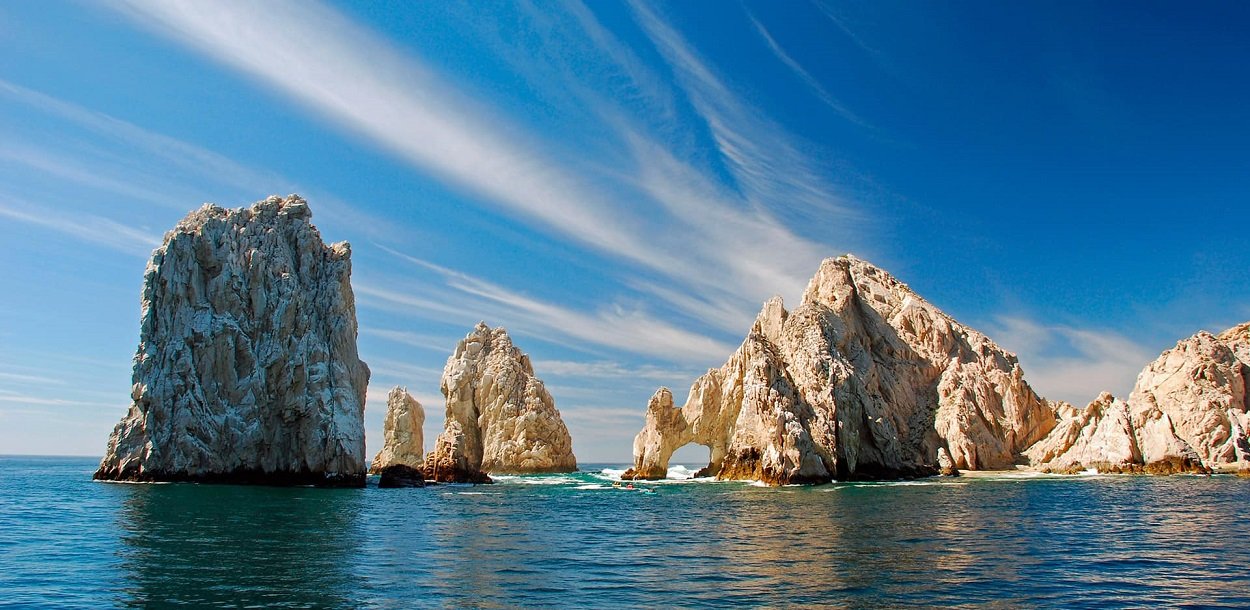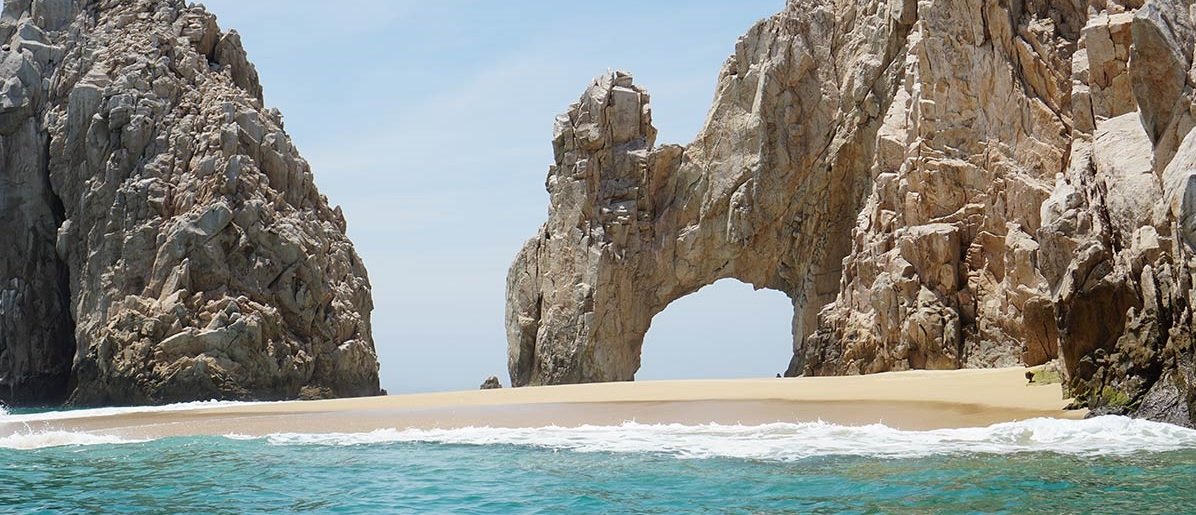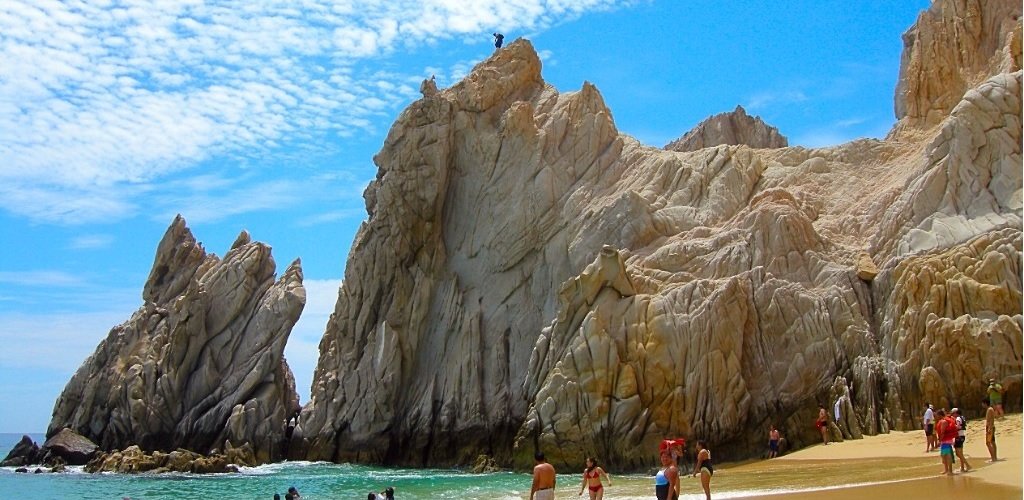You are surrounded by water on three sides due to your location on the Baja Peninsula; the Pacific Ocean can be found to the south and west, and the Sea of Cortez can be found to the east. Diver Jacques Cousteau is credited with coining the phrase "the world's aquarium" to refer to the Sea of Cortez because of its dense population of marine life.
Los Cabos is the perfect place to go to relax by the water because it has a coastline that reaches from the Sea of Cortez all the way to the Pacific Ocean, and there is an average of 350 sunny days per year. Surfers, golfers, divers, and hikers come to the southernmost tip of the Baja Peninsula because it feels like summer all year long and offers a wide variety of opportunities for outdoor recreation. Both San Lucas and San José del Cabo, which are sister towns, provide their visitors with a variety of unique activities, ranging from all-night bar crawls to Thursday-night art walks. The Corridor between them offers all-inclusive resorts that provide guests with everything they could want for the ideal honeymoon or family vacation.
When you arrive in Los Cabos, the first thing you should do is make a reservation for a boat trip to Land's End, which is located next to San Lucas. Granite rock formations in the shape of winding serpents denote the location of the entrance to the Pacific Ocean from the Sea of Cortez. The eponymous arch is a natural gateway in the shape of a circle, and if the tides are in your favor, you will be able to walk ashore and pass through it. The arch is just one of a number of otherworldly natural monuments, such as the Window to the Pacific, which is a rectangular hole in the cliffs through which you can see the ocean, and Neptune's Finger, which is a narrow stack that looks like a giant digit protruding from a hand that is underwater.
Playa del Amor, which is located on Land's End and faces north, is bordered on either side by the granite rocks that make up "El Arco." Playa del Amor is a tranquil cove that is tucked away from the crashing waves of the Pacific Ocean and is where boats drop off day-trippers so they can laze on the white sands, snorkel in the crystal clear waters, and climb on the rocks to get the best photos of this unparalleled location. If you require additional space to stretch out, the nearby Playa del Divorcio, which gets pounded by the waves of the Pacific Ocean, is a good option.
During the peak tourist season (November through June), Thursday evenings in San José are reserved for an art walk that runs from 17:00 until 21:00. This event was organized with the purpose of drawing people to the art district, which is comprised of art galleries and shops and is situated on the blocks behind the church.
Calle Alvaro Obregon, the town's main street, has become car-free as the art walk has gained popularity in the community. This has contributed to the ambiance of the event. Up to a dozen galleries located in the neighborhood take part in the event and host activities such as live music, meet and greets wine evenings, and lectures. Galleries like the Frank Arnold Gallery, Desert, and Casa Dahlia are just a few examples.

Between the months of December and April, Los Cabos is located directly on the path taken by humpback whales as they make their way to the warmer waters of the Pacific Coast of Mexico in order to give birth. As was previously mentioned, during these months it is possible to find a headland along the Corridor, and if you are patient enough, there is a good chance that you will see a fin or a tail. There is a list of companies that provide whale-watching tours that can be found in this directory. Companies such as Whale Watch Cabos are so confident that you will see whales during this five-month window that they offer free follow-up tours if you don't see anything on your initial excursion if you don't see anything on your first trip.
This attraction in Puerto Los Cabos spans an area of five hectares and contains more than 1,500 different species of cacti and succulents from around the world. The Wirikuta Botanical Cactus Garden was established as a kind of tribute to the plants that grow in desert environments, and it contains one million specimens that are arranged in strips and concentric circles. In addition, there is a fantastic sculpture garden at Wirikuta that showcases the works of prominent figures in Mexican modern art such as Gabriel Macotela, José Luis Cuevas, and Manuel Felguérez. The park plays host to traditional Huichol acrobatics and dance show every Wednesday night, and the level of production value in this show is surprisingly high.
The high-octane excitement of Baja California Sur's interior is best experienced in its raw desert landscape. Companies in San Lucas and San José will pick you up from your accommodation and take you out to the remote desert for high-speed drives, all of which will be captured by a professional photographer and will be followed by beers to help you wind down after the trip. ATV and buggy trips along dusty riverbeds are available for those who are looking for an adrenaline rush.
They also provide trips on ATVs and buggies, as well as bungee jumping, zip-lining across a wild desert canyon, and camel rides, to name a few of the activities they provide. For the younger members of the family, Wild Canyon provides a zoo with animals such as macaws, iguanas, crocodiles, and more camels that children can interact with.

Playa Santa Mara is a crescent-shaped cove that is guarded by two promontories. This beach is so beautiful that you won't ever want to leave. Due to the fact that these prevent the currents from entering, Playa Santa Maria is normally calm and clear even when other beaches are experiencing waves. Like the rest of the Los Cabos Corridor, there’s been an increase in construction at Playa Santa María. In the place where there was once a dirt track, there is now a brand-new bathroom as well as a parking lot. But as of early 2018, the beach still has an undiscovered feel, even when the boat-loads of snorkellers arrive early in the afternoon.
Todos Santos is a charming and historically significant town that has been recognized by Mexico's Secretariat of Tourism as a "Pueblo Mágico." It is located to the north of the municipality of Los Cabos, across the Sierra de la Laguna mountain range. This has a lot to do with the painted one-story houses, upscale restaurants, and arts and crafts shops that are located close to the Plaza del Pueblo, the central plaza of the town. The whitewashed mission can be found on the south side of that square, and on the western frontage of the building, there is a cinema that was built in Art Deco style in 1944. The beaches of Todos Santos are frequently pounded by waves from the Pacific Ocean. Although this does not make the beaches ideal for swimming, surfers are well aware of the excellent quality of the breaks at these beaches.
Divers will definitely want to include this marine reserve in their itineraries, but snorkeling and swimming in the reserve are also possible from the land if you pack the appropriate gear and head northeast from San Lucas or San José. In this sparsely populated area, you won't have much contact with the outside world, which is a big part of the excitement.
The interior is dominated by open spaces and cacti, while the coast is characterized by a series of imposing granite headlands that are interspersed with quiet coves. Even if you're just going snorkeling, the amount of marine life that you'll see in these waters will astound you because a national park has been established here to safeguard a series of coral reefs.

Climbing this rough-hewn peak on Land's End is one of the most rewarding free activities that visitors to Los Cabos have the opportunity to participate in. Even though the slopes of Mount Solmar appear to be difficult, the hike to the peak is feasible for people of most ages due to the rocks' ability to function as natural steps and the fact that the summit is only about 100 meters above sea level. The only challenging aspect is locating the trailhead, which is located on private property at a dog shelter; however, this information is simple to look up on the internet. As soon as you reach the peak, the vistas of Los Arcos and San Lucas Bay are better than you could ever have imagined.
Some sources claim that Cabos have as many as 350 days of sunshine per year, making it practically a year-round destination. On average, Cabos experiences about 300 days of sunshine per year.

The city of Cabos enjoys near-perfect weather for the majority of the year, with the exception of a brief rainy season that runs from the middle of July to the end of September.

There are two shoulder seasons in Cabo, and both of them are that enchanted time of year when the weather is still pleasant and the prices are still reasonable. It is best to schedule your trip for the months of April to May or October to November to take advantage of the shoulder season.

From July through September, the summer months offer the best value, so that's when you should travel if you want to get the most for your money. Even though we are in the middle of the rainy season in Cabo, the climate there makes it so that it doesn't rain very often. In the summer, in addition to the rain, the humidity is quite high; however, if you don't mind the less-than-ideal weather, you will be able to take advantage of lower prices and fewer people.

